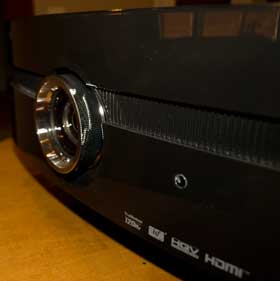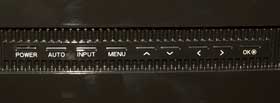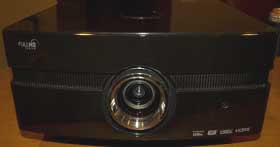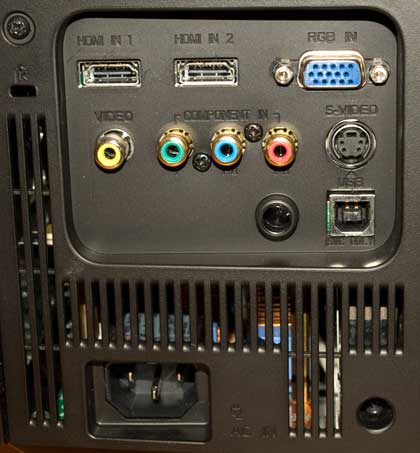LG AF115 Projector: Dynamic and Manual Iris
The iris mechanism of the LG projector offers five choices: Off - which means wide open iris; On, which gives you 32 step control of how far the iris is open (32 is wide open, the same as off); and three different dynamic iris modes.
So, you can use the iris manually, or dynamically, but not both (no big deal, but some might say it would be a plus to do both, because the LG is so bright.)
The three dynamic iris settings are Auto 1, 2, and 3. For "best mode" viewing, I worked with Auto 1, which provides the least overall brightness (but still plenty) and the blackest blacks of the three settings. Auto 2 is in the middle in overall brightness, and Auto 3, is virtually identical as wide open (at maximum), but doesn't close down as far, so less black improvement than Auto 1 or 2.
I'm definitely recommending Auto 1, for the blackest blacks. There's plenty of lumens behind Auto 1, so no problem there. I don't watch with dynamic irises on, on things such as sports, and most general HDTV programming, but, if I did, I'd probably select Auto 3.
Overscan Feature, and Edge Masking Issues
Like with the CF181D, the LG AF115 only offers overscan, and not edge masking. (That's very common.) Unfortunately, Overscan does not work with 1080i or 1080p sources, so it isn't available when my favorite HDTV channels happen to be running something where there's noise along the images, as often seems to be the case when low def is displayed - an example might be ESPN running Sports Center HD, and showing standard definition footage of a game. Let's just say, noise around the edges isn't rare, though some projectors are better than others to begin with.
This is potentially an issue, since when you get that jittery noise, say, along the top, you may not be able to rid your screen of it with the LG.
As it turns out, the LG is expecially good at handling the type of noise that makes you reach for overscan controls. I rarely spotted image noise along the edges. When I did, it was almost always on standard def TV, which (as long as you don't have your cable box or satellite box doing the upscaling) allows you to use the overscan.
So, while I'd be happier if the LG AF115 supported overscan at 1080 resolutions, it doesn't seem to be any kind of deal breaker issue.
Even forgetting that overscan 1080 issue, I personally prefer projectors to offer Edge Masking, either instead of, or in addition to, Overscan. The LG lacks edge masking as do probably a small majority of home theater projectors. The advantage of edge masking is that the overall image gets a couple of rows of pixels smaller, but you maintain 1:1 pixel mapping for the sharpest image. With Overscan you again eliminate a couple of rows of pixels on the outside, but then stretch what's left to fill the whole screen. You get the screen filled, but a touch of softness from the expansion, very similar to the softness caused by using Keystone Correction.
LG AF115 Physical Tour
Here we take a close look at the LG AF115 projector itself, its lens, inputs, menus, remote, and a whole lot more. Because it is essentially identical to the previously reviewed LG CF181D, we've lifted this page, almost word for word, from the previous review. Basically we simply used search and replace to change the projecor model name to AF115.
LG AF115 Physical Appearance
The LG AF115 home theater projector is a medium-largish black projector. It is essentially identical to the LG CF181D we reviewed several months back. Both weigh in just under 22 pounds. The AF115 has some styling, including a curved front, and a recessed band around the projector. Overall, it looks nice, but not overly impressive unless that it has a pretty massive look to it, compared to a lot of smaller home projectors. The lens is center mounted. To its right, is the front IR sensor (there's a second one in the back, on the input panel).
Interestingly, the control panel is in the back (see image and description below). The top only has a recessed ring for adjusting vertical lens shift, and around it, some indicator lamps. There's a blue LED trim ring around it, which makes for a pretty lighting when warming up or shutting down as the blue LED light rotates around the ring.
Two screw thread adjustable feet are found below the front on the left and right side. Vents run under the front of the projector and on the sides.
Inputs are all in the back. The LG projector comes with a very nice remote, which will also be discussed below. The lamp door is located on the bottom, but in a corner. It looks like, from the manual, that the lamp may be replaceable without unmounting a ceiling mounted projector. However, that's my best guess, and it assumes you go with the LG mount. If you go with a typical universal mount, my guess is that some will require unmounting, others may not. So, definitely consult with your dealer about that issue, especially if you are doing the work yourself, to make sure you buy a mount that makes sense.
Another maintenance issue is filter cleaning or replacement. The manual only says, "clean or replace the filter when the projector tells you to." They give no indication of that's after 100 hours or a 1000, or ??? The filter areas are in the bottom front vents, where you will find two filters. Yes, they can be cleaned, but if damaged, should be replaced.
Control Panel
The control panel consists of a row of buttons in a slightly recessed area on the right side of the back of the projector. I don't find that to be a very good location or design, but, hey, since once you start using the projector in its permanent place, you'll be relying on the remote control, let's not worry about that too much. Still, having navigation using a diamond, round or square arrow key layout, with a center Enter button is far easier to use than a linear run of buttons.
That said, the control panel does work fine. Looking at the control panel on the rear, from the back, finds the buttons organized this way, from left to right:
Power, Auto (setup, mostly for PCs), Input (source select), up, down, left, and right arrow buttons, and finally, the OK (enter) button. That's about your most basic control panel.
Input/Output
The AF115 is very typically equipped. In terms of inputs there are the usual two HDMI 1.3 inputs (I prefer to see 3, but that's very uncommon). Of course there's a component video input (3 color coded RCA jacks), and an HD15 analog computer input, which can double as a second component video input. That pretty much covers the highest quality inputs.
There's also the usual composite video and S-video inputs, not to mention an RS-232 and also a USB labeled "service only." According to LG, neither the USB or Serial port is set up to support command and control, such as working with a Crestron room control system.
Lacking as noted would be a (rare) 3rd HDMI, but also not there, one or two 12 volt "screen" triggers, and apparently a serial port for command and control. (As to screen triggers - nice to have, but there are usually work arounds available).





